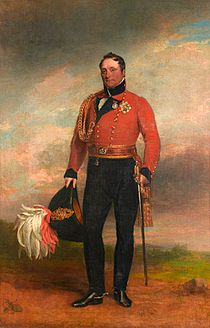Battle of Garris facts for kids
Quick facts for kids Battle of Garris |
|||||||
|---|---|---|---|---|---|---|---|
| Part of the Peninsular War | |||||||
|
|||||||
| Belligerents | |||||||
| Commanders and leaders | |||||||
| Strength | |||||||
| 7,000 | 11,000 | ||||||
| Casualties and losses | |||||||
| 500 killed, wounded or captured | 170 killed, wounded or captured | ||||||
The Battle of Garris (also known as the Battle of Saint-Palais) happened on February 15, 1814. It was a fight during the final stages of the Peninsular War. An Allied army, led by General Arthur Wellesley, attacked a French division. The French were commanded by General Jean Isidore Harispe.
The Allies pushed the French back into the town of Saint-Palais. This victory helped the Allies cross the Bidouze River. Before this, bad weather had stopped fighting for two months. Wellington then started a new attack, pushing the French back. The next big battle was the Battle of Orthez.
Contents
Why Did the Battle of Garris Happen?
The Winter Pause in the War
After the Battle of the Nive in December 1813, heavy rains made roads impossible to use. This forced a two-month break in the fighting. The French army, led by Marshal Jean-de-Dieu Soult, stayed near the fortresses of Bayonne and Saint-Jean-Pied-de-Port.
Wellington, the Allied commander, refused to attack in such bad weather. He believed it would harm his army for no good reason. He also sent most of his Spanish soldiers home. This was because they had caused trouble by taking things from French villages. Wellington wanted to avoid making French civilians angry.
Changes in the French and Allied Armies
In January 1814, the French army became smaller. Napoleon needed more soldiers to defend France itself. So, three French divisions and a cavalry brigade were sent away. Marshal Soult was left with about 60,000 soldiers.
Wellington's Allied army was larger, with over 70,000 soldiers. It included British, Portuguese, and a few Spanish troops. Wellington planned to attack the French by moving east. He wanted to draw Soult's army away from the important city of Bayonne.
The Start of Wellington's Attack
The rains finally stopped in February. Wellington began his attack on February 14. His right side, led by Rowland Hill, moved east. They headed towards a town called Hélette.
The French division under General Harispe was at Hélette. They had to retreat when Hill's forces advanced. Harispe's troops fell back towards the Bidouze River, near Saint-Palais.
What Happened During the Battle?
The French Take a Stand
General Harispe found a good spot to defend just west of Saint-Palais. It was a long ridge. He set up his 7,000 soldiers there, waiting for the Allies. Their only way to escape was a single bridge over the Bidouze River in Saint-Palais.
Late in the afternoon of February 15, the first Allied troops arrived. These were from William Henry Pringle's brigade, part of Hill's army. The soldiers were tired from their long march. They just wanted to set up camp for the night.
The Allied Attack
Suddenly, one of Wellington's assistants rode up. He ordered the troops to "Take that hill before dark!" The soldiers quickly got into a tight formation. They then charged towards the French on the ridge.
The Allies had about 11,000 men attacking. These included two British battalions and two Portuguese brigades. Pringle's battalions quickly fought their way to the top of the ridge. The French tried to fight back, but they couldn't push the Allies away.
The French Retreat
While the fighting continued on the ridge, Spanish and Portuguese troops began to move around the sides of the French army. Harispe saw that his outnumbered division was about to be surrounded. He ordered his soldiers to retreat.
With the Portuguese closing in on the bridge, the French retreat quickly turned into a rush to safety. Most of them made it across the bridge. However, the Allies captured about 200 French soldiers on the east bank. The French lost 300 men killed or wounded. The Allies had 170 casualties.
The French general, Harispe, couldn't get his soldiers to rally in Saint-Palais. They were too discouraged. He had to retreat further west. The French tried to blow up the bridge, but they didn't do a good job. The Allies were able to fix it quickly.
What Was the Outcome of the Battle?
Allies Cross the River
The Allied army successfully broke through the French defenses along the Bidouze River. On February 16, Marshal Soult pulled back two of his divisions. He left a strong French force of 14,000 men to defend Bayonne.
Soult then gathered his main army, about 32,000 infantry and 3,800 cavalry. He set up a new defensive line behind the Gave d'Oloron and Saison Rivers. Wellington's army, with 42,000 infantry and 3,000 cavalry, moved to face them.
Surrounding Bayonne
Meanwhile, the British began a daring plan to surround Bayonne. The Adour River near Bayonne was very wide and had strong tides. The French never thought anyone would try to cross it there, so they didn't guard that part of the river.
On February 23, British troops crossed the river to create a small base. That evening, 700 French soldiers came to investigate. They were scattered by new weapons called Congreve rockets. The next day, 34 ships were used as floating bridges, called pontoons. Planks were laid across them to make a road.
British troops poured across this new bridge. By February 27, the city of Bayonne was completely surrounded by the Allied forces. On that same day, the important Battle of Orthez took place.



